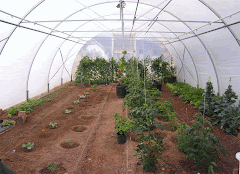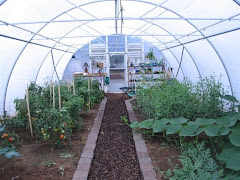
~*~*~*~*~*~*~
This week we are talking about Legumes (Beans)
Each person needs to have 60 lbs per year.
Buying Beans
Legumes of all types may be purchased in a number of different fashions depending largely on where you live and the time of year. The most basic form is called "field run" which means that it's been harvested and sold shortly thereafter. It will not have been given any cleaning or processing and is likely to be rather dirty depending upon the conditions under which it was grown and harvested.
A second basic form called "field run from storage" the legume has been harvested and then put into storage for a time. It will have all of the dirt and detritus of field run grain and whatever it may have picked up from the silo as well.
If you want legumes that are ready to use you will need to ask for "pre-cleaned" which means that it has been passed through fans, screens or sieves to remove chaff, smut balls, insect parts, mouse droppings and other debris.
Moisture Content
The moisture content of the legume you want to purchase or grow has a major impact on how long you will be able to store it and have it remain nutritious and edible. Mold and other fungi will grow in your beans if the moisture content is too high. For this reason, it is suggested you keep legumes to a moisture content of no more than 10%.
Nutrition
Unless one is willing to spend a great deal of money on preserved meats, you must have a quantity of legumes in your food storage program. There are few non-animal foods that contain the amount of protein to be found in dried beans, peas, and lentils. The varieties commonly available in this country have protein contents ranging from 20%-35%. As with most non-animal proteins, they are not complete in themselves for purposes of human nutrition, but become so when they are combined with the incomplete proteins found in grains. It is for this reason that grains and legumes are so often mentioned together. In cultures all over the world, it is common to find the two served together at a meal, making a complete protein, even when those doing the serving have no understanding of nutrition at all.
During the lean years of the Great Depression, beans were tagged "poor man's meat" because of their protein power at pennies per pound. Beans are a source of Niacin, Thiamin, Riboflavin, B6 vitamins and many other nutrients as well. They are also rich in complex carbohydrates and fiber. All of these nutrients are necessary for normal growth and for the building of body tissues. Beans are high in potassium which is required for the normal functioning of nerves and muscles. A cup of cooked beans contains more potassium than a banana. In fact, beans have more calcium and iron per cup than three ounces of cooked meat but contain no cholesterol and with less calories. Beans are the best source of folate and are excellent sources of minerals and vitamins. High in fiber they have good cancer fighting characteristics and have been specifically linked to lower the risk of colon cancer.
Recent research has brought to light that beans have 'anti-aging' agents or antioxidants found in the seed coat. There are eight flavonoids in the outer bean layer, six of which are particularly strong antioxidants. Because of new research, we are learning that beans have a perfect nutrient base for people interested in weight loss. They also aid in reducing cholesterol, improve digestion and, as already mentioned, are an aid in cancer prevention.
Preparing Legumes
Beans can be eaten raw, sprouted or cooked. They can even be ground into a flour and in this form beans cook up in two or three minutes into a hearty soup. But this is not all, for the more adventurous among us, beans can be juiced into milk, curdled into tofu, fermented into soy sauce or made into transparent noodles called vermicelli. Truly, beans rival the versatility of wheat in what you can do with them. Here are some of the different processes in preparing beans for eating.
Soaking
This step isn't completely necessary, however, there are some real advantages. A shorter cooking time is probably the biggest advantage. Figure about an extra hour of cooking time for beans that are not pre-soaked. Beans should be soaked for at least 6 hours. During this time, the beans will absorb water until they have increased in volume and weight about 3 times. You should add 5 times as much water as dry beans.
Soaking also leaches some of the gas producing properties out of the bean. But for this to work, you need to discard the soaking water and replenish it with fresh water before cooking. You can also quick soak beans by boiling them for 10 minutes first, then setting them aside for two hours. As with a cold soak, you should discard the soaking water and replace with it fresh water before cooking them. Boiling the beans kills the seeds so don't expect them to sprout after you've heated them. 1 lb. dry packaged beans = 2 cups dry = 6 cups cooked beans.
Cooking Beans
After soaking, most people cover the beans with water then boil them. This can take anywhere from 30 minutes to 2 hours, depending on the bean. You should check them for softness every 15-30 minutes then pull them off the heat when they've reached their desired softness.
But you can also throw them in a crock pot in the morning and let them go until the evening. Beans ground into a flour cook up almost instantly into a soup or paste, depending on how much water you use. If you've boiled your beans for several hours and they still haven't softened, it's probably because they are old. Older, air stored beans 5 or more years old get 'hardened' and may never soften up. There are two ways of getting around this. You can put them in a pressure cooker for 45-60 minutes and this should do the trick, or you can grind them. Incidentally, normal beans that aren't 'hard' cook in about 20 minutes is a pressure cooker. Hardened beans still contain much of their nutrition.
After your beans are cooked, add your flavorings, meat, vegetables or whatever you are adding to make the bean dish you are preparing. Don't add these ingredients while the beans are cooking as there are many ingredients that will increase the beans' cooking time before they become soft. This includes the acidic foods which include tomatoes, lemon juice, vinegar and similar ingredients.
Adding a bit of cooking oil, butter or margarine to the cooking beans will help to keep the foaming down as they cook. Consider cooking a double batch and freezing the beans not used immediately. Beans soaked for 12 hours or more often have a more uniform shape than quick soaked beans. You may need to increase the cooking time if your water is overly hard or you live at high altitudes. Cooked beans will store nicely in your refrigerator for a week and they freeze nicely for a minimum of 6 months.
What Are The Different Beans Used For?
Adzuki Japanese dishes.
Anasazi Can be used in place of Navy, Pinto, Great Northern, or Kidney beans.
Black-eye Rice dishes and southern cuisine.
Black Turtle Latin American dishes, soups, refried beans, salsas.
Garbanzo Soups, salads and Mexican dishes; Hummus and falafel. Coffee substitute.
Great Northern Soups, baked beans.
Kidney Soups, salads, sandwiches, chili, dip, or over rice.
Lentils Soups, raw sprouts, stirfried sprouts, meatless patties, Ethnic food.
Lima Vegetable side-dish or added to soups and casseroles.
Mung Sprouts, vermicelli or transparent noodles.
Navy Baked beans, soups, casseroles, ethnic dishes.
Pink Used to make chili. Good substitute for pinto or kidney beans.
Pinto Chili, refried beans, dips.
Small Red Chili, salads.
Soy Soy milk, tofu, soy flour, TVP, sprouts, tempeh, mise, soy sauce, natto
Bean Varieties
Black Beans
Also known as turtle beans, these small, dark-brownish black, oval-shaped beans are well known in southwestern black bean soups. They are very commonly used in Central and South America and in China. They tend to bleed very darkly when cooked so they are not well suited to being combined with other beans, lest they give the entire pot a muddy appearance.
Black-Eyed Pea
Although there is tremendous variation among the many varieties of field peas eaten throughout the Southern United States, it is black-eyed peas that are the most commonly known nationwide. The coloring of field peas is as varied as the rest of the legume family, with black-eyed peas being small and oval-shaped with an overall creamy color and, of course, their distinctive black-eye. Dried field peas cook very quickly and combine very tastily with either rice or cornbread.
Chickpeas
Also known as the garbanzo bean or cecci pea (or bean), it tends to be a creamy or tan color, rather lumpily roundish and larger than dried garden peas. Many have eaten chickpeas, even if they've never seen a whole one.
Kidney Beans
Just like the rest of the family, kidney beans can be found in wide variety. They come in both light and dark red color in their distinctive kidney shape. Probably best known here in the U.S. for their use in chili, they figure prominently in Mexican, Brazilian and Chinese cuisine.
Lentils
Lentils are an odd lot. They don't fit in with either the beans or the peas and occupy a place by themselves. Their shape is different from the other legumes being roundish little discs with colors ranging from muddy brown, to green to a rather bright orangish-red. They cook very quickly compared to the larger beans and have a distinctive flavor. They are much used in Asian cuisine from India to China. They make an excellent soup.
Lima Beans
In the Southern U.S., they are also commonly called butter beans. They are one of the most common beans found in this country in all manner of preservation from the young small beans to the large fully mature type. Their flavor is pleasant, but a little bland. Their shape is rather flat and broad with colors ranging from pale green to speckled cream and purple.
Peanuts
Peanuts are another odd species not much like the more familiar beans and peas. Peanuts have a high protein percentage and even more fat. They are one of the two legume species commonly grown for oilseed in this country, and are also used for peanut butter, boiled and roasted peanuts.
Pinto Beans
The Pinto is the most commonly eaten beans in the U.S. at an average of 3.5 pounds per person. Stereotypically bean shaped, it has a dappled pattern of tans and browns on its shell. Pintos have a flavor that blends well with many foods.
Soybeans
This legume has the highest protein content.. The beans themselves are small, and round with a multitude of different shades. Although the U.S. grows a very large percentage of the global supply of these beans, we eat very few of them Most of them go into cattle feed, are used by industry or exported. What does get eaten directly has usually been processed in some form. Almost all prepared and "junk food" has some form of soy in it. Soybean products range from tofu to textured vegetable protein and hundreds of other uses. More and more people are developing allergies to the soy when it is broken down from it’s original state, however most of these people can still eat the soy in it’s natural form,. Although they are very high in protein, they don't lend themselves well to just being boiled until done and eaten the way other beans and peas do.
Beans Giving You Gas?
My brothers use to sing..."Beans, beans the musical fruit, the more you eat the more you toot.."
Beans have a reputation of producing gas. The reason for gas is caused by a lack of enzymes in the intestinal tract needed to digest this food. As your body gets used to eating beans, the needed enzymes are introduced and this problem disappears. Unfortunately the only way to develop the enzymes necessary to handle beans is to eat them, It is recommended that to get use to them you need to eat them 2-3 times a week for about a month, increase it thenext month, after that you shouldn’t have any problems.
There are several things you can do to minimize or eliminate this. First, pick a bean that is not as gas-producing as the others. Here is a scale of beans sorted according to their gas
producing qualities (1=more gas, 10=less gas):
1. Soybeans
2. Pink beans
3. Black turtle beans
4. Pinto beans
5. Small white beans
6. Great northern
7. Baby lima beans
8. Garbanzo beans
9. Large lima beans
10. Black-eyed peas
11. Anasazi beans
The longer you soak them the less gassy beans will be. You can also drain the water after 12 hours, then rinse and re-drain them every 12 hours for 2 to 3 days until the sprouts are as long as the bean. This not only dramatically increases the vitamins in the beans but also removes some of the gas producing qualities. After you have sprouted them as described above, cook them like regular soaked beans. As mentioned already, you should throw out the water you've been soaking your beans in before cooking them.
There are a herbs and spices that also reduce or eliminate the gas from beans. Peppermint, spearmint, marjoram, anise, basil, caraway, carrots, dill, ginger, onions orange juice, parsley, savory, thyme and ginger are reported to have gas reduction properties to one extent or another as well.
Try drinking orange juice with your bean meals.
The tale of throwing a carrot in with the beans as they cook then throwing it out is also founded on successful experience.
It is also reported that fruits shouldn't be eaten at the same meal.
Another way to eat beans to eliminate the gas problem is to grind them into flour in a grinder or heavy duty blender. Add to boiling water and make an instant soup of thickener. Use 2 tbls of bean flour in place of 1 tbls cornstarch. Bean flour can be used in any recipe calling for flour by replacing up to 24% of the flour with any variety of bean flour.
This week challenge:
Make a meal with beans in at least one of the dishes
Then please share with all of us your favorite bean recipe, next week I would like to share a bunch of bean recipes with the group.
The California Bean Board
The USDA
Revelar, Inc
.
Best of Basics by James Talmadge
~*~*~*~*~*~*~*
Disclaimer:
This e-mail is sent solely for the purpose of educating you in the are of preparedness
It is not meant as a forecast of any event.
@ Bucket Ideas Copyright
~~~~~~~~~~~~~~~~~~~~~~~~~~~~~~~~~~~~~~~~~~~~~~~~~~~~~~~~~~~~~~~~~~~~~~~~~~~~~~~
2)-16-18 oz. cans of pork-n-beans
3/4 c. brown sugar
1 tsp dry mustard
6 slices of bacon
1/2 c ketchup
350 1 1/2 hrs.
Grandma Hardman's Baked Beans
2 lrg. cans pork-n-beans drain off juice and remove pork.
1/3 - 1/2 C. Molasses
1/2 - 1 C. Br. Sugar
1 tsp. mustard
This recipe is gauged purely by taste adjust amounts until you get the flavor you want.
Bean Burrito Pie
1 can (16oz) refried beans
1 c. bisquick
1/4 c. water
Spread mixture in bottom & halfway up side of greased 10" deep pie plate.
Layer in order:
1 lb. browned hamburger (drained)
1 slice avacado (optional)
1 cup thick salsa
1 1/2 C. shredded cheese
Bake for 30 min. at 375. each piece may be served with sour cream. 8
servings
My favorite Chili with Beans Recipe, we always have this with scones.
2 lbs ground beef
1 lrg Green pepper diced
1 lrg. onion diced
1 lrg garlic cloved, minced
1/3 c. chili powder
2) 15 1/4 to 19 oz red kidney beans (drained, save the juice)
1) 28 oz. can tomatoes
1) 6 oz. can tom. paste
3.4 C. water
1/2 tsp. salt
1 tsp sugar
1 bay leaf
Cook Beef & vegi's together until browned. Stir in chili powder & liquid
from kid. beans. Stir in tom.'s, paste, water, slt, sugar and bay leaf.
Simmer 45 min. stir in reserved kidney beans. you can top with cheese.
From Jennifer my niece:
of cold water all night, and we weren't gassy at all after eating them, yeah!
Black Bean Fudge
4 squares chocolate, unsweetened 1 1/2 cubes butter 1 teaspoon vanilla extract 1 2/3 cups black beans, cooked 2 1/2 pounds powdered sugar Melt unsweetened chocolate squares with butter. Mix in drained and mashed black beans, vanilla extract, and sugar. Place mixture in a large buttered, shallow cookie pan, ie. 10 x 15-inch jelly roll pan. Refrigerate. Makes from 2 1/2 to 3 pounds of fudge.
Disclaimer:
This e-mail is sent solely for the purpose of educating you in the are of preparedness
It is not meant as a forecast of any event.
Please close with prayer
Copyright Bucket Ideas@
~~~~~~~~~~~~~~~~~~~~~~~~~~~~~~~~~~~~~~~~~~~~~~~~~~~~~~~~~~~~~~~~~~
I found a great info site about beans--thought you might like to look at it. It is about pressure cooking beans http://missvickie.com/howto/beans/howtobeantypes.html Many factors influence cooking times. Use this information as a guideline, but the actual cooking times may vary depending on your pressure cooker, heat source and the quality and/or quantity of the beans. See more information about how beans are classified and how that relates to cooking times and digestability, and why some beans are more difficult to digest than others. Drain the soaked beans and rinse well, add enough water to cover the beans by at least 2 inches, but do not fill the pressure cooker more than 1/2 full. Beans are always cooked at high pressure and use the natural release method to drop the pressure. Find recipes for beans and other legumes. | ||||||||||||||||||||||||||||||||||||||||||||||||||||||||||||||||||||||||||||||||||||||||||||||||||||||||||||||||||||||||||||||||||
As a general rule, beans should be soaked before cooking. Rinse and add beans to the pressure cooker, add enough water to cover by 2 inches. It is recommended to add 1-2 tablespoons of fat (cooking oils, butter, lard, bacon drippings) to minimise foaming. Lock the lid in place and cook according to the following chart. In all cases beans should be finished using the natural release method. | ||||||||||||||||||||||||||||||||||||||||||||||||||||||||||||||||||||||||||||||||||||||||||||||||||||||||||||||||||||||||||||||||||
| ||||||||||||||||||||||||||||||||||||||||||||||||||||||||||||||||||||||||||||||||||||||||||||||||||||||||||||||||||||||||||||||||||



























 Scarlet Runner Beans
Scarlet Runner Beans









No comments:
Post a Comment